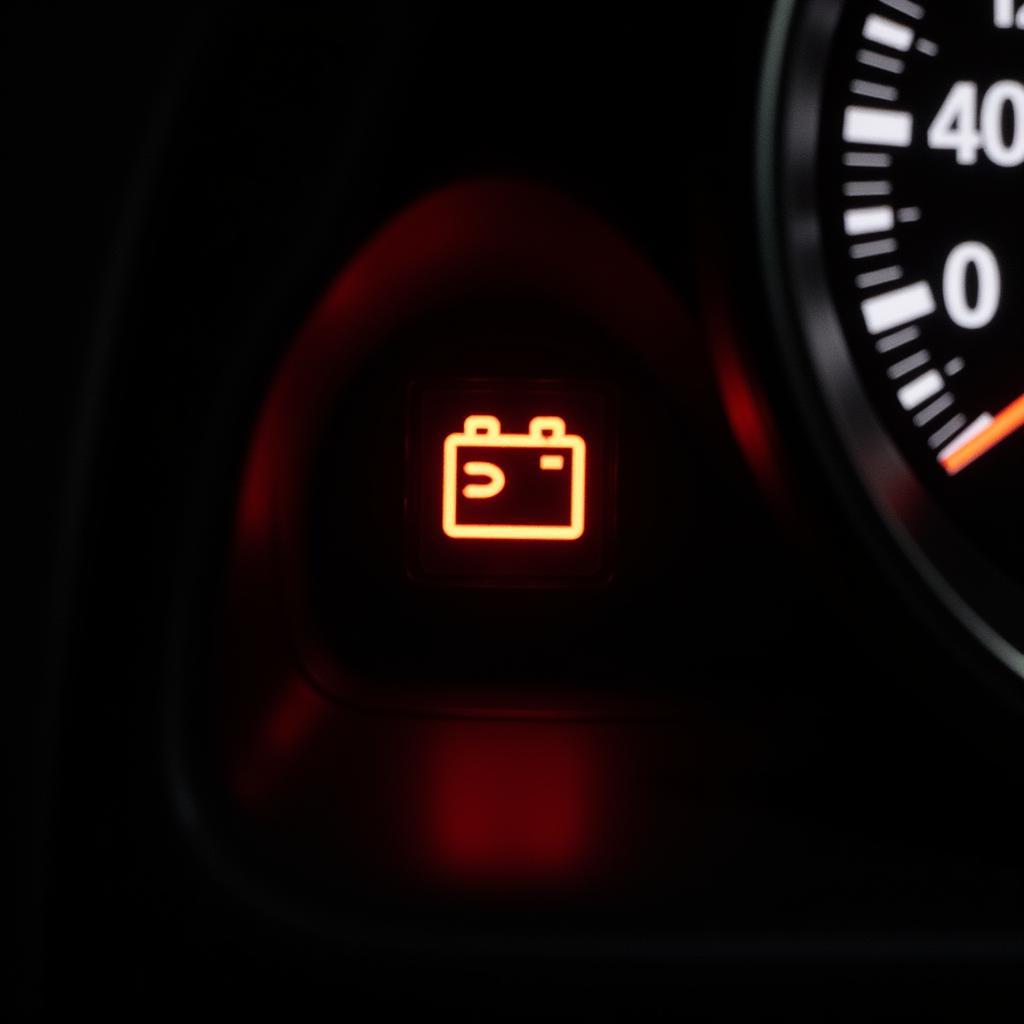The battery icon on your car dashboard is a critical indicator of your vehicle’s electrical system health. Seeing it illuminated or behaving strangely can be concerning. This guide provides a comprehensive overview of the battery light, its various meanings, and how to troubleshoot common issues.
Decoding the Battery Light: What Does it Mean?
The battery light, often a red battery-shaped symbol, typically indicates a problem with the charging system. This doesn’t always mean the battery itself is failing. It could signal issues with the alternator, voltage regulator, or wiring. Understanding the different scenarios is key to effective troubleshooting.
Battery Light On While Driving
If the battery light comes on while driving, it’s a serious warning. It means your alternator isn’t charging the battery properly, and your car is running solely on battery power. This power is finite, so you need to act quickly.
- Immediate Action: Turn off any unnecessary electrical loads, like the radio, air conditioning, and headlights.
- Find a Safe Place: Safely pull over and stop the engine as soon as possible. Continuing to drive could lead to a complete electrical system failure.
- Seek Professional Help: Call a roadside assistance service or tow your vehicle to a qualified mechanic for diagnosis and repair.
 Car battery light illuminated while driving
Car battery light illuminated while driving
Battery Light Flickering or Dim
A flickering or dimly lit battery light can be just as troubling as a fully illuminated one. It might suggest a loose connection, a failing alternator, or a problem with the serpentine belt. Ignoring this intermittent warning sign could lead to more significant problems down the line.
- Check Connections: Inspect the battery terminals and cables for corrosion or looseness. Clean and tighten them if necessary.
- Inspect the Serpentine Belt: Ensure the belt driving the alternator is properly tensioned and not frayed or cracked.
- Consult a Mechanic: If the flickering persists, consult a qualified mechanic to diagnose the issue.
Battery Light On When Starting
Seeing the battery light momentarily illuminate when you start the car is normal. It simply indicates the system is performing a self-check. However, if the light stays on after the engine starts, it signifies a problem with the charging system.
- Check the Battery: Ensure the battery terminals are clean and tightly connected.
- Test the Alternator: Have the alternator tested at an auto parts store or by a mechanic to determine if it’s functioning correctly.
- Inspect Wiring: Check the wiring connecting the battery and alternator for damage or loose connections.
Why is My Car Battery Light On But the Battery is Good?
A common misconception is that an illuminated battery light automatically means a dead battery. As discussed earlier, it often points to a faulty charging system.
- Alternator Issues: A malfunctioning alternator is the most frequent culprit. It might not be producing enough voltage to charge the battery.
- Voltage Regulator Problems: The voltage regulator controls the alternator’s output. A faulty regulator can overcharge or undercharge the battery.
- Wiring Faults: Damaged or corroded wiring can disrupt the flow of electricity between the alternator and the battery.
Expert Insights: Troubleshooting the Battery Light
“Many drivers panic when they see the battery light, assuming their battery is dead,” says automotive electrical specialist, David Miller, ASE Certified Master Technician. “However, more often than not, the issue lies with the charging system, particularly the alternator. A proper diagnosis is crucial before replacing any components.”
“A simple voltage test can reveal a lot about the charging system’s health,” adds Miller. “A healthy system should show around 14 volts with the engine running. Lower readings indicate a problem with the alternator or voltage regulator.”
Preventing Battery and Charging System Problems
Regular maintenance can prevent many battery and charging system issues. Here are some preventative measures:
- Regular Battery Inspections: Clean battery terminals and check for corrosion regularly.
- Alternator Testing: Periodically test your alternator to ensure it’s functioning correctly.
- Serpentine Belt Inspection: Check the serpentine belt for wear and tear and replace it as needed.
Conclusion: Addressing the Battery Icon Car Dashboard Warning
The battery icon on your car dashboard is a vital warning sign. Understanding what it means and taking prompt action can prevent a minor issue from becoming a major inconvenience. By following the troubleshooting tips outlined in this guide, you can identify and address the root cause of the problem, keeping your car running smoothly and reliably. Don’t hesitate to seek professional help if you’re unsure about any aspect of the diagnosis or repair.
FAQ: Common Questions about the Battery Light
-
Q: Can I jump-start my car if the battery light is on? A: Yes, you can jump-start the car to get to a safe location or a mechanic. However, it’s not a permanent solution.
-
Q: How long can I drive with the battery light on? A: This varies depending on the battery’s condition and the electrical load, but it’s best to stop as soon as it’s safe to do so.
-
Q: Can a bad battery cause the alternator to fail? A: A failing battery can put extra strain on the alternator, potentially shortening its lifespan.
-
Q: How much does it cost to replace an alternator? A: The cost depends on the vehicle make and model, but typically ranges from $300 to $800.
-
Q: How often should I replace my car battery? A: Most car batteries last between 3 and 5 years.
-
Q: Can I drive at night with the battery light on? A: It’s highly discouraged, as your headlights will drain the battery quickly, increasing the risk of a complete electrical failure.
-
Q: What other dashboard lights are related to the battery light? A: The check engine light might also illuminate if there are issues with the charging system.


